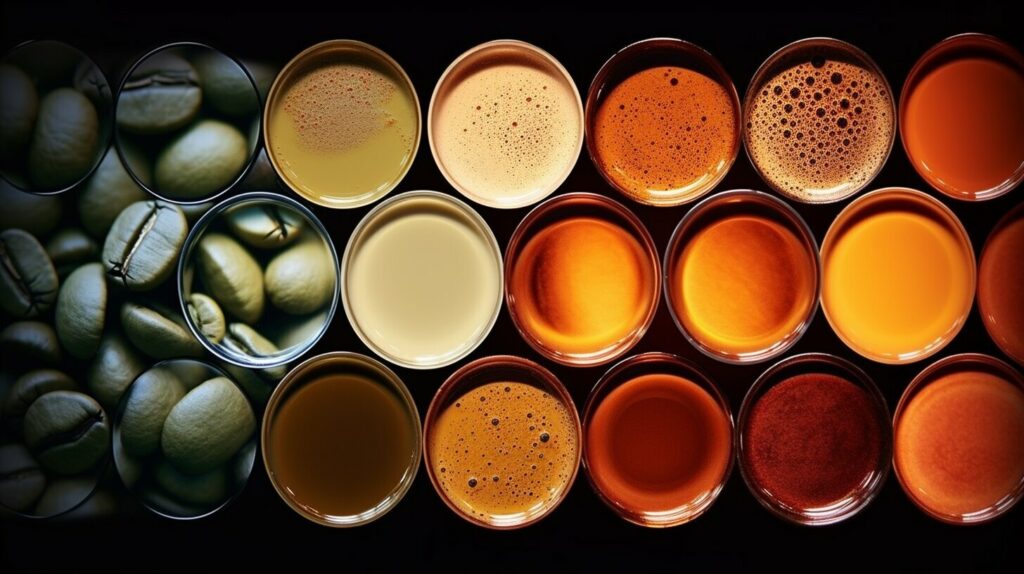Is Coffee Acidic? What You Need to Know About Coffee Acidity.
Coffee acidity is a topic that often sparks curiosity among coffee lovers. Understanding the acidity of coffee and its effects on both the flavor of your brew and your health is essential. Many people wonder, “Is coffee acidic?” Let’s explore the fascinating world of coffee acidity and uncover the truth behind this intriguing characteristic.
- Coffee is considered acidic, with an average pH value of 4.85 to 5.10.
- Acidity in coffee refers to a flavor characteristic, not the level of acid content.
- Lighter roasts generally have higher acidity, while darker roasts tend to be less acidic.
- Factors such as brewing method, roast level, and grind size can affect the acidity of coffee.
- Cold brewing coffee can reduce its acidity by about 70%.
Now that we’ve laid the foundation, let’s dive deeper into the world of coffee acidity, exploring its nature, impact, and ways to manage it according to your preferences and health considerations.
The Acidity of Coffee: Explained
When we talk about the acidity of coffee, we are not referring to the actual level of acid present in the coffee but rather to the perceived sharpness and brightness that acidity imparts to the flavor. It’s important to note that acidity in coffee is a desirable characteristic, contributing to the overall taste experience.
The acidity of coffee varies, depending on factors such as the type of coffee beans and the roasting process. Lighter roasts generally have higher acidity compared to darker roasts. This is because the longer roasting time of dark roasts breaks down the acids in the coffee, resulting in a smoother and less acidic cup.
Factors such as brewing method, roast level, and grind size can all affect the acidity of the final brew. Cold brewing coffee, for example, can reduce its acidity by about 70%. This brewing method involves steeping coffee grounds in cold water for an extended period, resulting in a less acidic and smoother cup of coffee.
| Type of Coffee | Acidity Level |
|---|---|
| High-altitude premium coffees from Central America | Bright and vibrant acidity |
| Brazilian or Sumatra coffee | Low acidity |
It’s worth noting that high acidity in coffee may aggravate certain health conditions such as acid reflux or irritable bowel syndrome (IBS). In such cases, it is recommended to choose less acidic varieties or explore decaffeinated options. Additionally, adding eggshells to the brewing process or selecting finely ground coffee beans can help neutralize acidity.

In summary, the acidity of coffee is not a measure of its acid content, but rather a flavor characteristic that adds sharpness and brightness to the overall taste. Lighter roasts tend to have higher acidity, while factors like brewing method and grind size can also influence acidity levels. Cold brewing is an effective method to reduce acidity, and different types of coffee can vary in their acidity levels. It’s important to consider personal preferences and health conditions when choosing the acidity level of your coffee.
Understanding Coffee pH Levels
Coffee typically falls within a pH range of 4.85 to 5.10, indicating its slightly acidic nature. While pH levels are not a direct measure of acidity, they are useful for understanding the general level of acidity in coffee. It’s important to note that acidity in coffee is not related to the level of acid present in the coffee itself. Instead, acidity is a flavor characteristic that contributes to the overall taste experience.
Acidity in coffee is often described as a sharp and crisp sensation, adding brightness and complexity to the brew. Different types of coffee beans and the roasting process can influence the acidity levels. Lighter roasts generally have higher acidity compared to darker roasts. The brewing method, roast level, and grind size can all impact the acidity of the final cup of coffee.
To reduce the acidity in coffee, cold brewing is an effective method. By steeping coffee grounds in cold water for an extended period, cold brewing can decrease acidity by about 70%. Cold brew coffee is known for its smoother and less acidic flavor profile. Choosing darker roasts, using coarser grind settings, and brewing at lower temperatures can also help reduce acidity. Additionally, some high-quality coffee beans naturally have lower acidity levels.
Table: Acidity Levels of Different Coffee Beans
| Coffee Type | Acidity Level |
|---|---|
| Premium coffees from Central America | Bright and vibrant acidity |
| Brazilian or Sumatra coffee | Low acidity |
It’s worth noting that individuals with conditions like acid reflux or irritable bowel syndrome (IBS) may want to choose coffee with lower acidity to avoid aggravating their symptoms. High acidity in coffee can lead to increased discomfort for those with such conditions. Experimenting with different coffee varieties and finding one with the right acidity level can help individuals enjoy their coffee without compromising their health.
Overall, understanding coffee acidity and its impact on brew and taste is essential for any coffee enthusiast. Whether you prefer a bright and acidic cup or a milder and less acidic one, adjusting various factors such as roast level, brewing method, and bean origin can help you achieve your desired flavor profile.

Several factors contribute to the acidity of coffee, including the type of coffee beans, the roasting process, and even the altitude at which the beans are grown. Understanding these factors can help coffee lovers navigate the world of acidity and find the perfect cup to suit their taste preferences.
The Type of Coffee Beans
Different types of coffee beans have varying levels of acidity. For example, Arabica beans are known for their bright and lively acidity, while Robusta beans tend to have a more intense and sometimes harsh acidity. Specialty coffee enthusiasts often prefer Arabica beans for their complex flavors and balanced acidity.
The Roasting Process
The roasting process also plays a significant role in coffee acidity. Lighter roasts generally have higher acidity compared to darker roasts. During the roasting process, the sugars in the coffee beans caramelize, leading to a decrease in acidity. Therefore, if you prefer a less acidic cup of coffee, opting for a darker roast may be a good choice.
The Altitude of the Beans
The altitude at which the coffee beans are grown can impact their acidity. Coffee beans grown at higher altitudes, such as those in Central America, often exhibit brighter and more vibrant acidity. This is because the cooler temperatures and slower maturation process at high altitudes allow the beans to develop more complex flavors and higher acidity. On the other hand, coffee beans grown at lower altitudes, like those from Brazil or Sumatra, tend to have lower acidity levels.
In conclusion, the acidity of coffee is influenced by multiple factors, including the type of coffee beans, the roasting process, and the altitude at which the beans are grown. These factors contribute to the diverse range of flavors and acidity levels found in different coffee varieties. By understanding these factors, coffee enthusiasts can make informed choices and explore the world of acidity to find their perfect cup of coffee.
| Factor | Impact on Acidity |
|---|---|
| Type of Coffee Beans | Affects the intensity and flavor profile of acidity. |
| Roasting Process | Lighter roasts tend to have higher acidity, while darker roasts have lower acidity. |
| Altitude of the Beans | Higher altitude beans often have brighter acidity, while lower altitude beans have lower acidity. |
How Coffee Acidity Affects Brew and Taste
Coffee acidity plays a crucial role in shaping the flavors of your brew, adding complexity and vibrancy that contribute to a delightful taste experience. When you take a sip of coffee with high acidity, you’ll notice a bright and sharp sensation that enlivens your palate. This acidity acts as a natural flavor enhancer, heightening the sweetness and fruitiness of the coffee. It brings a pleasant tanginess that is often described as “wine-like” or “citrusy,” creating a well-rounded and memorable taste.
One of the key effects of coffee acidity is that it adds brightness to the overall flavor profile. Just like a squeeze of lemon juice can transform a dish, the acidity in coffee lifts the flavors and makes them more pronounced. It balances out the richness and heaviness, preventing the brew from tasting flat or dull. This vibrant acidity is especially desirable in certain coffee varieties, such as African beans known for their lively and tangy profiles.
“The acidity in coffee lifts the flavors and makes them more pronounced.”
However, it’s important to note that acidity levels can vary depending on factors like roast level and brewing method. Lighter roasts generally have higher acidity compared to darker roasts, as the prolonged roasting process reduces the acidity. Additionally, the grind size can also influence the extraction and perception of acidity in the coffee. Finer grinds tend to produce more acidic flavors, while coarser grinds have a milder and smoother taste.
To fully appreciate the impact of acidity on your coffee, it’s necessary to experiment with different beans and brewing techniques. Whether you prefer a bright and tangy cup or a smoother, well-rounded brew, understanding the influence of acidity allows you to customize your coffee experience to suit your taste preferences.

| Coffee Type | Acidity Level |
|---|---|
| High-altitude premium coffees from Central America | Bright and vibrant acidity |
| Brazilian or Sumatra coffee | Low acidity |
The Impact of Coffee Acidity on Health
While coffee acidity adds to the overall flavor profile, it can have implications for individuals with certain health conditions, such as acid reflux or IBS. The high acidity in coffee can exacerbate symptoms and discomfort for those suffering from these conditions. It is important for individuals with such health concerns to understand the impact of coffee acidity and make informed choices about their coffee consumption.
Acid reflux, also known as gastroesophageal reflux disease (GERD), occurs when stomach acid flows back into the esophagus, causing a burning sensation and discomfort. Coffee is often listed as a trigger for acid reflux due to its high acidity. The acidic nature of coffee can irritate the lining of the esophagus, leading to increased reflux symptoms. Individuals with acid reflux may find relief by opting for less acidic coffee varieties or exploring alternative brewing methods that reduce acidity, such as cold brewing.
Similarly, individuals with irritable bowel syndrome (IBS) may experience worsened symptoms with high-acidic coffee. IBS is a chronic digestive disorder that can cause abdominal pain, bloating, and changes in bowel movements. Coffee’s acidity can stimulate the production of stomach acid, potentially triggering symptoms in individuals with IBS. It may be beneficial for these individuals to choose low-acidic coffee options or explore alternative brewing techniques that minimize acidity.
Overall, understanding the impact of coffee acidity on health is crucial for individuals with acid reflux, IBS, or other related conditions. By making informed choices about the acidity level of their coffee and exploring alternative brewing methods, they can enjoy their favorite beverage while minimizing potential discomfort and symptoms.

If you prefer a less acidic brew or want to minimize the impact of acidity on your stomach, there are several methods you can try to reduce the acidity in your coffee.
One effective method is cold brewing. Cold brewing coffee involves steeping coffee grounds in cold or room temperature water for an extended period of time, usually 12 to 24 hours. This method reduces the acidity of the coffee by about 70% compared to hot brewing methods. The slower extraction process at lower temperatures produces a smoother and less acidic cup of coffee. To try cold brewing, simply combine coffee grounds and water in a jar or pitcher, let it steep, and then strain the liquid to remove the grounds before enjoying your low-acidity coffee.
Another way to reduce acidity is by choosing darker roasts. Lighter roasts tend to have higher acidity, while darker roasts have a milder, less acidic flavor profile. The longer roasting process breaks down the acids in the coffee, resulting in a smoother taste. Additionally, using coarser grind settings and brewing at a lower temperature can help minimize acidity in your coffee.
If you’re looking for natural ways to neutralize acidity, you can try adding eggshells to the brewing process. Crushed eggshells can help reduce the acidity by absorbing some of the acid compounds. Simply add a few crushed eggshells to your coffee grounds before brewing. Another option is to choose coffee beans that are naturally low in acidity. Some coffee varieties, like Brazilian or Sumatra coffee, are known for their low acidity levels.
| Method | Effectiveness |
|---|---|
| Cold Brewing | Reduces acidity by about 70% |
| Choosing darker roasts | Produces a milder, less acidic flavor |
| Using coarser grind settings | Minimizes acidity in coffee |
| Adding crushed eggshells | Neutralizes acidity |
| Opting for naturally low-acidity coffee beans | Reduces acidity levels |
Experimenting with different methods and finding the one that suits your taste preferences and stomach sensitivity is key. It’s worth noting that the acidity of coffee is a natural component of its flavor profile, and reducing acidity too much may alter the overall taste. Ultimately, finding the right balance between acidity and flavor is a personal preference.

Unlocking the Secrets of Cold Brewing
Cold brewing has gained popularity among coffee enthusiasts due to its ability to significantly reduce the acidity of coffee while preserving its flavors. This method involves steeping coffee grounds in cold water for an extended period, typically overnight, resulting in a smooth and less acidic cup of joe.
One of the primary reasons why cold brewing reduces acidity is the lower brewing temperature. Unlike traditional hot brewing methods, cold brewing uses room temperature or chilled water, which extracts fewer acidic compounds from the coffee grounds. As a result, the final brew has a milder and less sharp taste, making it perfect for those with a sensitive stomach or acid reflux.

In addition to the lowered brewing temperature, the extended brewing time is another key factor in reducing coffee acidity. Cold water takes longer to extract the flavors from the coffee grounds, resulting in a more balanced and less acidic brew. This prolonged contact time allows for a smoother extraction, highlighting the more subtle flavors and minimizing the acidic notes.
Cold brewing also offers flexibility when it comes to customization. You can experiment with different coffee-to-water ratios, grind sizes, and brewing times to fine-tune the acidity level according to your preferences. Additionally, cold brewing can be enjoyed over ice or used in various coffee-based beverages, making it a versatile technique for both hot and cold coffee lovers.
To summarize, cold brewing is a favored method for reducing coffee acidity while preserving its flavors. With its lower brewing temperature, extended steeping time, and customizable options, cold brewing unlocks a world of smooth, less acidic coffee experiences. So why not give it a try and savor the refreshing taste of a perfectly balanced cup of joe?
Exploring Different Coffee Types and Acidity Levels
Coffee from different regions and varieties can exhibit varying levels of acidity, leading to diverse taste profiles and experiences. The acidity in coffee plays a crucial role in determining its overall flavor and sensory characteristics. Let’s take a closer look at some of the different coffee types and their acidity levels:
High-Altitude Premium Coffees
High-altitude coffee beans, particularly those from Central America, are known for their bright and vibrant acidity. These beans are grown at higher elevations, which allows them to develop complex flavor profiles with a pronounced acidity. The acidity in these coffees adds a lively and refreshing quality to the cup, enhancing the overall taste experience. If you enjoy a lively and tangy flavor, these high-altitude premium coffees are worth exploring.
Brazilian Coffee
On the other end of the acidity spectrum, Brazilian coffee is known for having a lower acidity level. The climate and growing conditions in Brazil produce coffee beans with a milder and smoother taste profile. The lower acidity in Brazilian coffee results in a more balanced and mellow cup. If you prefer a coffee with less pronounced acidity and a well-rounded flavor, Brazilian coffee is an excellent choice.
Sumatra Coffee
Sumatra coffee, hailing from Indonesia, is renowned for its unique flavor profile characterized by low acidity. The coffee beans from Sumatra undergo a distinct wet-hulling process, which contributes to their earthy and full-bodied taste. The low acidity in Sumatra coffee allows the other flavor notes, such as chocolate and spice, to take center stage. If you appreciate a rich and bold coffee with minimal acidity, Sumatra coffee is a great option to explore.
| Coffee Type | Acidity Level |
|---|---|
| High-Altitude Premium Coffees | Bright and vibrant |
| Brazilian Coffee | Low |
| Sumatra Coffee | Minimal |
Understanding the acidity levels of different coffee types can help you choose the perfect brew that aligns with your taste preferences. Whether you’re seeking a zesty and invigorating cup or a smooth and well-balanced flavor, exploring the diverse range of acidity in coffee will lead you to delightful and unique taste experiences.

Coffee acidity is a complex and fascinating characteristic that adds depth and flavor to our daily brew, and it’s crucial to navigate it wisely based on our preferences and health needs. The average pH value of coffee falls between 4.85 to 5.10, categorizing it as acidic. However, it’s important to note that acidity in coffee does not correspond directly to the level of acid in the coffee itself. Rather, acidity in coffee refers to a sharp and crisp sensation that enhances the overall taste.
Factors such as the type of coffee beans and roasting process can significantly influence the acidity levels. Lighter roasts tend to have higher acidity compared to darker roasts, which are often smoother and less acidic. Additionally, the brewing method, grind size, and temperature also impact the acidity of the final cup of coffee.
Cold brewing coffee is a widely recommended method for reducing acidity. Cold brewing can reduce the acidity of coffee by about 70%, resulting in a smoother and less acidic cup. This method involves a longer brewing time and lower temperature, which helps minimize the acidic characteristics of the coffee.
When exploring different coffee types, it’s important to consider their acidity levels. High-altitude premium coffees from Central America often exhibit bright and vibrant acidity, which adds complexity to the flavor profile. On the other hand, Brazilian or Sumatra coffee is known for its lower acidity, providing a milder taste experience.
For individuals with conditions such as acid reflux or irritable bowel syndrome (IBS), high acidity in coffee may aggravate their symptoms. In such cases, it is recommended to opt for less acidic varieties of coffee. Dark roasts, cold brewing, using a coarser grind, and brewing at a lower temperature are all effective ways to reduce acidity in coffee. Adding eggshells to the brewing process or choosing fine ground coffee beans can also help neutralize acidity, providing a smoother and more enjoyable coffee experience.
FAQ
Is coffee acidic?
Coffee is considered acidic with an average pH value of 4.85 to 5.10. The acidity of coffee is not related to the level of acid in the coffee but is instead a flavor characteristic.
What factors influence coffee acidity?
Factors such as brewing method, roast level, and grind size can affect the acidity of coffee. Lighter roasts generally have higher acidity compared to darker roasts.
How does coffee acidity affect taste?
Acidity in coffee is described as a sharp and crisp sensation, and it enhances the overall taste of the coffee. It adds brightness and complexity, enhancing the flavor experience.
Can coffee acidity impact health?
Coffee with high acidity may aggravate conditions like acid reflux and IBS, so it is recommended to choose less acidic varieties in such cases.
What are some ways to reduce acidity in coffee?
Some ways to reduce acidity in coffee include choosing dark roasts, cold brewing, increasing brew time, opting for coarser grind, and brewing at a lower temperature.
How can cold brewing reduce coffee acidity?
Cold brewing coffee can reduce its acidity by about 70%. The extended brewing time and lower temperature of the cold brewing process result in a smoother and less acidic cup of coffee.
Which coffee types have different acidity levels?
High-altitude premium coffees from Central America tend to have bright and vibrant acidity, while Brazilian or Sumatra coffee is known for having low acidity.
Can acidity in coffee be neutralized?
It’s also possible to neutralize acidity by adding eggshells to the brewing process or choosing fine ground coffee beans.
Source Links
- https://www.healthline.com/nutrition/is-coffee-acidic
- https://www.verenastreet.com/blogs/all-about-coffee/what-is-coffee-acidity
- https://www.gridlockcoffee.com.au/blog/ways-to-make-your-coffee-less-acidic/








